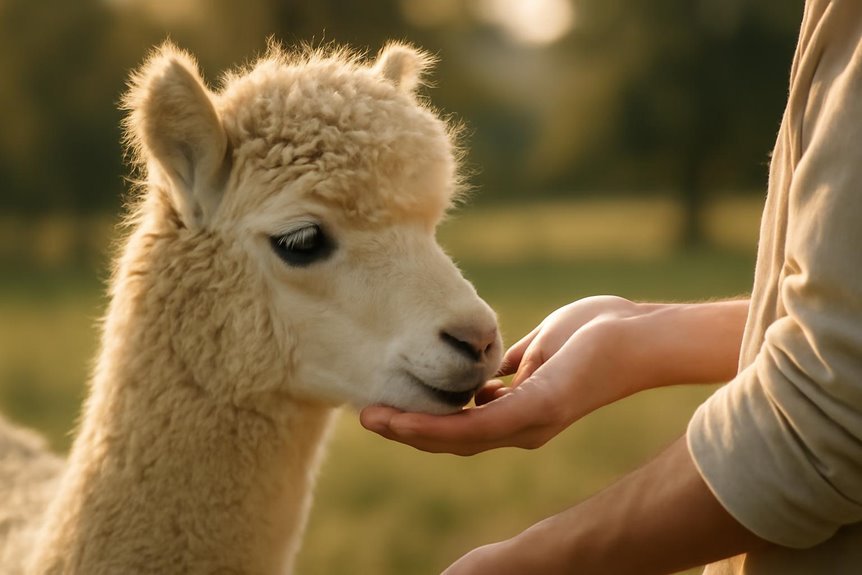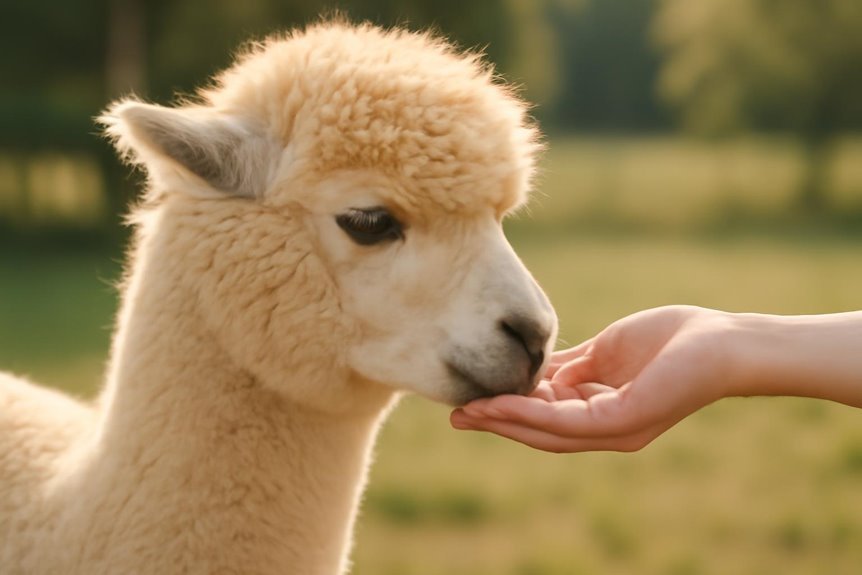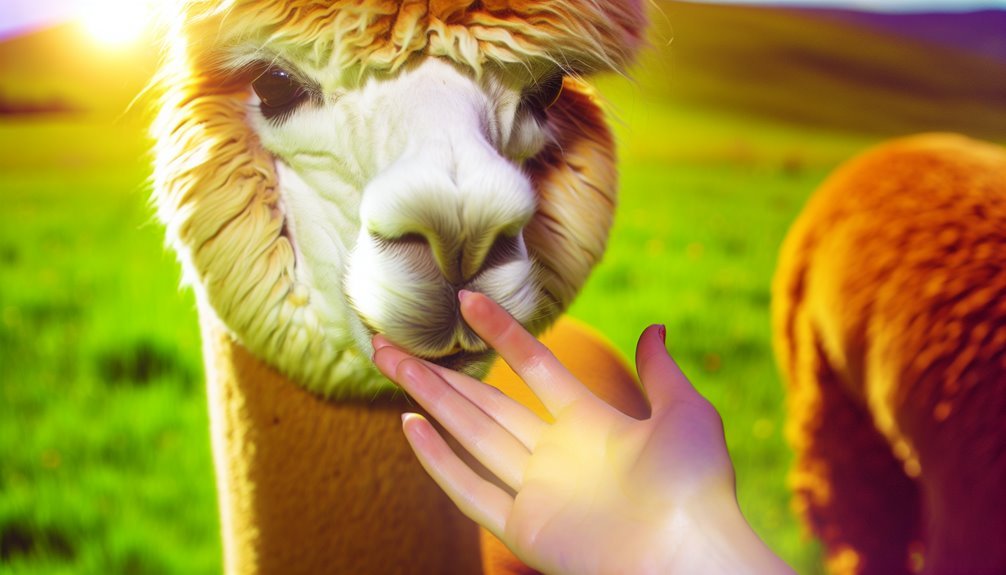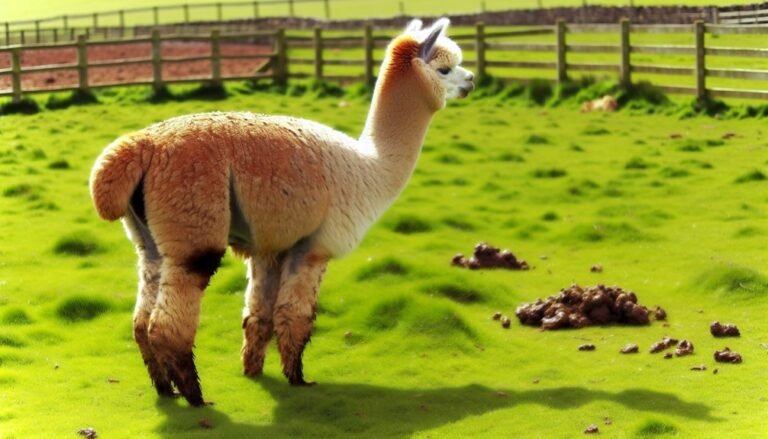Why Do Alpacas Respond Well to Gentle Training?
You’ll find alpacas respond best when you build trust through calm, gentle training that respects their instincts. Using positive reinforcement and gentle handling reduces their stress and encourages cooperation. They pick up on your body language and subtle cues, so consistency and patience are key. Training within their herd dynamic also supports learning and lowers anxiety. This approach not only improves behavior but strengthens your bond over time. Understanding these methods can truly transform your training experience.
Key Takeaways
- Gentle training builds trust, reducing alpacas’ stress and resistance during interactions.
- Positive reinforcement links commands to rewards, encouraging willingness to cooperate.
- Calm handling respects alpacas’ personal space, preventing fear and anxiety.
- Training within herd dynamics leverages social learning and reduces isolation stress.
- Consistent, gentle methods foster long-term bonds and improve responsiveness to cues.
The Importance of Trust in Alpaca Training

Because alpacas respond best when they trust you, building that trust is essential for successful training. When you establish a reliable and calm connection, you positively influence alpaca behavior, making them more open to learning. Gentle training methods that focus on consistent, fair handling help cultivate this trust, reducing stress and resistance during sessions. It’s important to remain calm and supportive, as your emotional reactions can affect how alpacas perceive and respond to you. Since alpacas have long-term memories, every positive interaction strengthens their trust, creating a lasting bond. By prioritizing trust, you set the foundation for effective communication and cooperation, ensuring your alpacas are willing and attentive partners in their training journey.
Recognizing and Responding to Alpaca Cues
You’ll want to pay close attention to your alpaca’s body language and sounds, as these signals reveal how they’re feeling. Using clear, consistent cues helps your alpaca understand what you expect, making training smoother for both of you. By recognizing and responding to these signals, you build trust and encourage positive behavior.
Understanding Alpaca Signals
Reading alpaca signals is key to building a trusting relationship and effective training. Since alpacas communicate mainly through body language, vocalizations, and ear positions, you’ll need to pay close attention to these subtle cues. They respond well to gentle, minor signals rather than loud or obvious commands, which helps them stay calm and cooperative.
To better understand alpaca signals, watch for:
- Ear positions indicating curiosity or discomfort
- Humming as a sign of contentment or communication
- Body posture showing relaxation or alertness
- Distress signs like spitting or snorting
- Subtle movements that signal readiness or hesitation
Using Clear, Consistent Cues
Recognizing the subtle signals alpacas use is just the start; responding with clear, consistent cues helps them understand what you want. When raising alpacas, using predictable verbal or physical signals builds trust and encourages cooperation. Try using their name as a pre-cue to catch their attention before giving a command. This alerts alpacas and prepares them to respond. Keep your tone calm and specific to avoid sounding harsh, creating a relaxed training atmosphere. Progressive cues—offering a sequence of signals—allow alpacas to grasp behaviors gradually, reinforcing learning over time. By maintaining consistency in your cues, you make interactions smoother and reduce the need for forceful commands. This gentle approach supports both you and your alpacas in building a positive, trusting bond.
The Role of Positive Reinforcement
When you reward your alpacas for good behavior, they start to connect those actions with positive outcomes, making training smoother. This gentle approach helps build trust over time, so your alpacas become more willing to follow your cues. Encouraging desired behaviors with kindness sets the foundation for a strong, respectful bond.
Encouraging Desired Behaviors
Although alpacas may seem independent, they’ll respond much better when you use positive reinforcement like treats or praise to encourage desired behaviors. By consistently rewarding good actions, you help alpacas link your commands with positive outcomes, making them more enthusiastic to repeat those behaviors. Encouraging desired behaviors through kindness creates a training environment where alpacas feel safe and motivated. Remember, their long-term memory means positive experiences stick, improving your interactions over time.
- Use treats or verbal praise immediately after a correct response
- Be consistent with commands and rewards
- Keep training sessions short and gentle
- Recognize small progress and reward it
- Avoid punishment to maintain trust and cooperation
This approach makes training effective and strengthens your bond with these intelligent animals.
Building Trust Gradually
Since building trust with alpacas takes time, using positive reinforcement is key to making the process smoother and more effective. When you consistently reward desirable behaviors, alpacas begin to associate your cues with positive outcomes, encouraging them to repeat those actions. This approach helps establish a trusting relationship, as alpacas feel safe and respected during gentle handling. Regular, kind interactions boost their confidence and improve their understanding of commands. By introducing training gradually and maintaining consistency, you help alpacas develop long-term memories of trust and safety. This not only makes them more responsive but also reduces stress for both you and the animal. Ultimately, positive reinforcement lays the foundation for a trusting relationship that supports successful, gentle training.
How Alpacas Interpret Human Body Language
Because alpacas are highly observant, they pick up on your body language and react best to calm, gentle movements. When you keep your posture relaxed and respect their personal space, alpacas as pets feel safe and are more willing to engage with you. Sudden gestures or loud noises can startle them, breaking the trust you’ve built with gentle training. You’ll notice alpacas quickly learn to associate specific, soft cues with comfort and safety, making your interactions smoother.
- Maintain a relaxed posture to invite trust
- Approach slowly to honor their personal space
- Use soft facial expressions to convey calm
- Avoid sudden movements or loud sounds
- Recognize their ability to link names with actions for better communication
Building Consistency With Verbal and Physical Signals
When you use consistent verbal and physical signals, your alpaca learns to anticipate what you want, making training smoother and more effective. Alpacas are herd animals, so they naturally respond well to predictable cues that mimic social interactions. Using your alpaca’s name as a pre-cue alerts them before you ask for movement, enhancing clarity. Subtle physical signals work best—minor hints rather than obvious gestures—helping your alpaca stay relaxed and engaged. Your tone of voice also matters; using specific, gentle tones improves communication without sounding commanding. This consistency builds trust, which is essential since alpacas are excellent pets that thrive on clear, reliable communication. By combining these approaches, you create a positive training environment that your alpaca understands and respects.
Avoiding Stress Through Gentle Handling

Building consistency with gentle signals sets the stage for stress-free interactions with your alpaca. Gentle handling is key because alpacas are stress animals that react negatively to sudden or harsh movements. By treating them calmly and respectfully, you help them feel safe and secure, reducing their anxiety and resistance. Remember, when you avoid stress through gentle handling, you encourage cooperation and trust.
Consistent, gentle handling fosters trust and reduces stress, creating calm and cooperative alpacas.
To do this effectively:
- Approach calmly and avoid sudden movements
- Use positive reinforcement to build trust
- Respect their personal space to prevent fear
- Maintain consistent, gentle touch and voice
- Observe body language to adjust your approach
These steps guarantee your alpaca responds positively, making training a smoother, more enjoyable experience for both of you.
The Impact of Herd Dynamics on Training Success
Although alpacas respond well to gentle handling individually, their natural herd instincts play an essential role in training success. When you train alpacas within their social group, they observe and mimic positive behaviors, making the process smoother. Herd dynamics, including the presence of a clear leader, greatly influence how well they respond to cues. Alpacas tend to trust and follow an established alpha, which you can leverage to improve training success. Also, recognizing individual roles in the herd helps you tailor gentle techniques—lower-ranking alpacas feel safer and learn better when their social standing is respected. Avoid separating them from the group during training, as isolation causes stress and agitation. Embracing herd dynamics creates a cooperative atmosphere, enhancing trust between you and your alpacas.
Long-Term Benefits of Gentle Training Methods
If you commit to gentle training methods with your alpacas, you’ll notice lasting benefits that go beyond immediate behavior improvements. This approach builds trust and respect, making your alpacas more cooperative and less stressed during training and routine care. Over time, these positive interactions create strong, peaceful bonds that simplify future handling.
Gentle training fosters trust and lasting bonds, making alpacas more cooperative and stress-free.
- Builds a foundation of trust and respect
- Enhances responsiveness to commands and cues
- Reduces stress, contributing to better health
- Encourages relaxed, confident behavior in various settings
- Makes ongoing training and handling more effective
Frequently Asked Questions
What Do Alpacas Respond To?
You’ll find alpacas respond best to your calm body language and consistent positive reinforcement. When you use gentle cues and rewarding interactions, they’re more likely to trust you and follow commands effectively.
How Do You Know if an Alpaca Likes You?
If an alpaca’s body language is an open book, you’ll see it leaning into you and humming softly. These social interactions show it trusts and enjoys your company, following you and responding warmly to your presence.
Why Are Alpacas so Friendly?
You’ll find alpacas friendly because their social behavior makes them thrive in group settings. Their positive animal interactions help them build strong bonds with both peers and humans, fostering trust and friendliness over time.
What Are the Behavioral Adaptations of an Alpaca?
You’ll notice alpacas show strong social behavior, relying on herd dynamics to stay safe and connected. They communicate through body language and vocalizations, adapting their behavior to cooperate and maintain harmony within their group.








Our picks
Alpaca & Wool Felted Sole Inserts: Comfy Upgrade?
Best Alpaca Socks for Hiking: Ultimate Comfort and Durability on Trails
Best Alpaca Halter for Comfort and Control